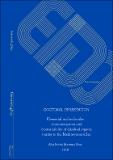Por favor, use este identificador para citar o enlazar a este item:
http://hdl.handle.net/10261/166283COMPARTIR / EXPORTAR:
 SHARE
BASE SHARE
BASE
|
|
| Visualizar otros formatos: MARC | Dublin Core | RDF | ORE | MODS | METS | DIDL | DATACITE | |

| Título: | Elemental and molecular characterization and bioavailability of dissolved organic matter in the Mediterranean Sea |
Autor: | Martínez-Pérez, Alba María CSIC ORCID | Director: | Álvarez-Salgado, Xosé Antón CSIC ORCID; Nieto-Cid, Mar CSIC ORCID | Fecha de publicación: | 2018 | Resumen: | The chemical composition and bioavailability of dissolved organic matter (DOM) in the
dark ocean is still enigmatic. To better understand the role played by DOM in the global ocean
carbon cycle, it is crucial to decipher its composition and mechanisms of production and
degradation. Knowing how DOM persists for hundreds to thousands years in the ocean is also
pivotal. Within this framework, the main purpose of this PhD thesis is to shed light on the
elemental and molecular composition of DOM, identify the environmental drivers of DOM
variability and gain knowledge about DOM bioavailability.
This PhD thesis is framed in the trans–Mediterranean cruise HOTMIX 2014. The
Mediterranean Sea (MedSea) is an oligotrophic semi–enclosed basin suitable to study the
DOM dynamics as it comprises water mass formation areas with its own thermohaline
circulation. The smaller size and faster ventilation rates of the MedSea compared to the global
ocean allow DOM changes to be observed in shorter spatial and temporal scales. Further, the
high temperature of the deep waters stimulates DOM mineralization in the dark MedSea The variability of dissolved organic carbon (DOC) and the absorption coefficient of colored DOM (CDOM) at 254 nm (a254) in the epipelagic layer of the MedSea was mostly explained by the apparent oxygen utilization (AOU). In the deep layer, water mass mixing and basin–scale mineralization processes contributed more substantially to explicate their variability. Further, considering the eastern and western basins separately, DOC contributed to 66 ± 10% of the oxygen demand in the eastern basin and to 24 ± 4% in the western basin. These results indicate that local mineralization processes of DOC and CDOM play a more relevant role in the eastern than the western MedSea. In addition, we identified 4 fluorophores in the MedSea: three humic–like and one protein–like. In the epipelagic layer, the distribution of marine humic–like substances was mainly driven by AOU suggesting that those compounds are by–products of mineralization processes. On the contrary, protein–like fluorescence was mainly driven by prokaryotic heterotrophic abundance. Again, in the deep layer mixing processes exhibited more influence on FDOM variability in the eastern than in the western basin. The molecular composition of DOM in the MedSea was also studied and water mass origin and DOM biodegradation were identified as the main drivers. Deep waters in the eastern basin exhibited significant molecular differences linked to their formation site, Adriatic versus Aegean Sea, and their formation time. Exploring the link between optical and molecular properties of DOM, it was found that 52% of the molecular formulae were correlated with one or more optical parameter. Furthermore, multiple linear regressions models to estimate molecular indices from optical indices were established for the first time. Finally, we assessed the reactivity of DOM transported by the intermediate waters of the MedSea by following in situ the evolution of two size–fractionated fractions (high and low molecular weight). Larger molecules were the only responsible for the oxygen consumption, resulting more reactive than the smaller counterpart and, therefore, verifying the size reactivity continuum hypothesis on the field. Further, in parallel to this DOC consumption, a decline of the protein–like substances together with a production of humic–like substances occurred in both size fractions, also corroborating the microbial carbon pump model |
Descripción: | 306 pages | URI: | http://hdl.handle.net/10261/166283 |
| Aparece en las colecciones: | (IIM) Tesis |
Ficheros en este ítem:
| Fichero | Descripción | Tamaño | Formato | |
|---|---|---|---|---|
| Tesis_Alba_Mtnz-Perez_2018.pdf | 15,79 MB | Adobe PDF |  Visualizar/Abrir |
CORE Recommender
Page view(s)
347
checked on 23-abr-2024
Download(s)
696
checked on 23-abr-2024
Google ScholarTM
Check
NOTA: Los ítems de Digital.CSIC están protegidos por copyright, con todos los derechos reservados, a menos que se indique lo contrario.
